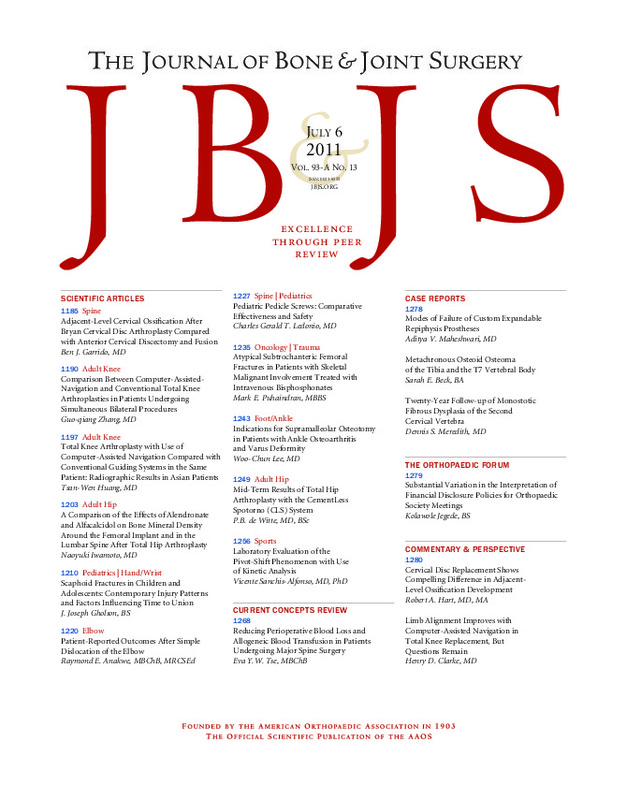JavaScript is disabled for your browser. Some features of this site may not work without it.
Buscar en RiuNet
Listar
Mi cuenta
Estadísticas
Ayuda RiuNet
Admin. UPV
Laboratory Evaluation of the Pivot-Shift Phenomenon with Use of Kinetic Analysis
Mostrar el registro sencillo del ítem
Ficheros en el ítem
| dc.contributor.author | Sanchis Alfonso, Vicent
|
es_ES |
| dc.contributor.author | Baydal Bertomeu, José Mª
|
es_ES |
| dc.contributor.author | Castelli ., Andrea
|
es_ES |
| dc.contributor.author | Montesinos Berry, Erik
|
es_ES |
| dc.contributor.author | Marín Roca, Susana
|
es_ES |
| dc.contributor.author | Garrido Jaen, Jose David
|
es_ES |
| dc.date.accessioned | 2014-11-04T16:22:36Z | |
| dc.date.available | 2014-11-04T16:22:36Z | |
| dc.date.issued | 2011-07 | |
| dc.identifier.issn | 0021-9355 | |
| dc.identifier.uri | http://hdl.handle.net/10251/43863 | |
| dc.description.abstract | Background: Currently, a suitable and reliable noninvasive method to evaluate rotational stability in vivo in anterior cruciate ligament-deficient knees, particularly during sports movements, does not exist. We speculated that if there is a rotational instability, the patient would avoid reaching a high pivoting moment during pivoting activities as a defense mechanism, and that the ground reaction moment, as registered by dynamometric platforms, would be reduced. On the basis of this hypothesis, we developed a study using kinetic analysis to evaluate rotational stability under dynamic loading. Methods: Thirty recreationally active athletes, including fifteen healthy subjects and fifteen with an anterior cruciate ligament-deficient knee, were recruited for this study. Patients performed jumping with pivoting with internal tibial rotation and external tibial rotation on the dynamometric platform with both the healthy and the injured limb. The quantitative results were graphically plotted, and the following parameters were evaluated: loading moment, pivoting moment, torque amplitude, loading slope, pivoting slope, percentage of pivoting with load, loading impulse, pivoting impulse, and maximum body rotation angle. Results: There were no significant differences between the dominant and nondominant knees in the control group during the jumping with pivoting and external tibial rotation test with regard to the pivoting moment (p = 0.805), pivoting slope (p = 0.716), pivoting impulse 2 (p = 0.858), and pivoting impulse 3 (p = 0.873). In patients with a chronic tear of the anterior cruciate ligament, there was a significant decrease of the pivoting moment (p = 0.02), pivoting slope (p = 0.005), pivoting impulse 2 (p = 0.006), and pivoting impulse 3 (p = 0.035) during the jumping with pivoting and external tibial rotation test in the anterior cruciate ligament-deficient knee compared with the healthy, contralateral knee. Conclusion: Kinetic analysis with use of a dynamic platform can objectively detect alterations of rotational stability in anterior cruciate ligament-deficient knees, which may allow this to be a useful research tool for evaluating treatment strategies in patients with anterior cruciate ligament injuries. Level of Evidence: Diagnostic Level IV. See Instructions to Authors for a complete description of levels of evidence. | es_ES |
| dc.language | Español | es_ES |
| dc.publisher | Journal of Bone and Joint Surgery, Inc | es_ES |
| dc.relation.ispartof | Journal of Bone and Joint Surgery, American Volume | es_ES |
| dc.rights | Reserva de todos los derechos | es_ES |
| dc.subject | CRUCIATE LIGAMENT RECONSTRUCTION | es_ES |
| dc.subject | ACL-DEFICIENT KNEE | es_ES |
| dc.subject | ANTERIOR | es_ES |
| dc.subject | KINEMATICS | es_ES |
| dc.subject | JOINT | es_ES |
| dc.subject | REHABILITATION | es_ES |
| dc.subject | MOVEMENT | es_ES |
| dc.subject | RUPTURE | es_ES |
| dc.subject | LAXITY | es_ES |
| dc.subject | INJURY | es_ES |
| dc.title | Laboratory Evaluation of the Pivot-Shift Phenomenon with Use of Kinetic Analysis | es_ES |
| dc.type | Artículo | es_ES |
| dc.identifier.doi | 10.2106/JBJS.J.00582 | |
| dc.rights.accessRights | Abierto | es_ES |
| dc.contributor.affiliation | Universitat Politècnica de València. Instituto Universitario Mixto de Biomecánica de Valencia - Institut Universitari Mixt de Biomecànica de València | es_ES |
| dc.description.bibliographicCitation | Sanchis Alfonso, V.; Baydal Bertomeu, JM.; Castelli ., A.; Montesinos Berry, E.; Marín Roca, S.; Garrido Jaen, JD. (2011). Laboratory Evaluation of the Pivot-Shift Phenomenon with Use of Kinetic Analysis. Journal of Bone and Joint Surgery, American Volume. 93(13):1256-1267. doi:10.2106/JBJS.J.00582 | es_ES |
| dc.description.accrualMethod | S | es_ES |
| dc.relation.publisherversion | http://dx.doi.org/10.2106/JBJS.J.00582 | es_ES |
| dc.description.upvformatpinicio | 1256 | es_ES |
| dc.description.upvformatpfin | 1267 | es_ES |
| dc.type.version | info:eu-repo/semantics/publishedVersion | es_ES |
| dc.description.volume | 93 | es_ES |
| dc.description.issue | 13 | es_ES |
| dc.relation.senia | 211730 |








